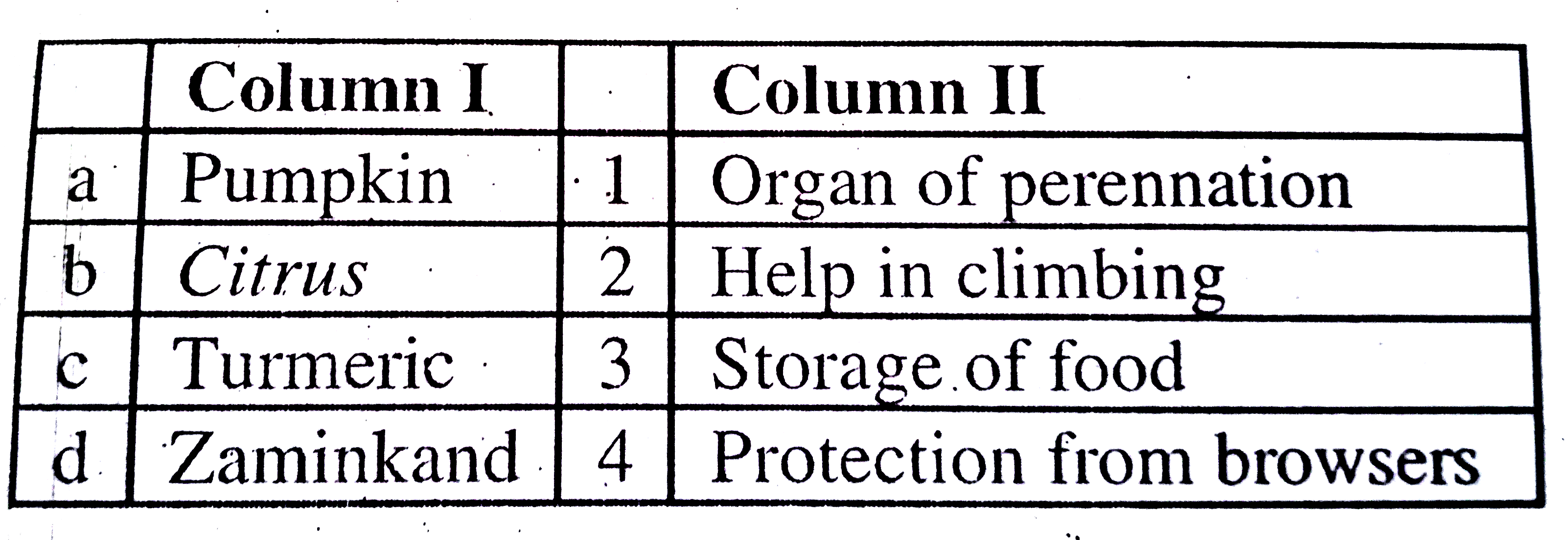Match the columns and choose the right options
III(a)Ginger(1)Flattened stems(b)Pumpkin(2)Thorns(c)Bougainvillea(3)Stem tendrils(d)Opuntia(4)Underground stem
a-4, b-3, c-2, d-1
a-4, b-1, c-2, d-3
a-2, b-4, c-1, d-3
a-3, b-4, c-2, d-1
The correct Answer is:A
To solve the matching question, we need to identify the correct modifications of the stems for each plant listed in column I.
1. Identify the first plant (Ginger):
- Ginger is known to grow from an underground stem, which is a modification called a rhizome.
- Therefore, we match Ginger (a) with Underground stem (4).
2. Identify the second plant (Pumpkin):
- Pumpkins have stem tendrils that help them climb and support themselves.
- Thus, we match Pumpkin (b) with Stem tendrils (3).
3. Identify the third plant (Bougainvillea):
- Bougainvillea is characterized by having thorns, which serve as a defense mechanism against herbivores.
- Hence, we match Bougainvillea (c) with Thorns (2).
4. Identify the fourth plant (Opuntia):
- Opuntia, commonly known as prickly pear, has flattened stems that perform photosynthesis.
- Therefore, we match Opuntia (d) with Flattened stems (1).
Final Matches:
- (a) Ginger → (4) Underground stem
- (b) Pumpkin → (3) Stem tendrils
- (c) Bougainvillea → (2) Thorns
- (d) Opuntia → (1) Flattened stems
Summary of Matches:
- A → 4
- B → 3
- C → 2
- D → 1
- Ginger is known to grow from an underground stem, which is a modification called a rhizome.
- Therefore, we match Ginger (a) with Underground stem (4).
- Pumpkins have stem tendrils that help them climb and support themselves.
- Thus, we match Pumpkin (b) with Stem tendrils (3).
- Bougainvillea is characterized by having thorns, which serve as a defense mechanism against herbivores.
- Hence, we match Bougainvillea (c) with Thorns (2).
- Opuntia, commonly known as prickly pear, has flattened stems that perform photosynthesis.
- Therefore, we match Opuntia (d) with Flattened stems (1).
- (a) Ginger → (4) Underground stem
- (b) Pumpkin → (3) Stem tendrils
- (c) Bougainvillea → (2) Thorns
- (d) Opuntia → (1) Flattened stems
- A → 4
- B → 3
- C → 2
- D → 1
Topper's Solved these Questions
Similar Questions
Match the columns and choose the correct option
(,I,,II),((a),Bulliform cells,(1),intitaion),((b),peicycle,(2),Root),((c),Endarch xylem,(3),Grasses),((d),Exarch Xylem,(4),Dicot leaf),((e)Bundle sheath cells,(5),stem )
View SolutionMatch the column and select the correct option.
Column - IColumn - II(1)Leaf tendril(i)Cactus(2)Leaf Spine(ii)Pea(3)Stem tendril(iii)Bougainvillea(4)Stem thorn(iv)Gourds(v)Turmeric
View SolutionMatch the columns and choose the right option
IIIa.Leptotene1.Terminalisation of chiasmab.Zygotene2.Crossing over and recombinationc.Pachytene3.Synapsisd.Diakinesis4.Visibility of chromosomes.
View SolutionMatch the columns and choose the right option
III(a)Amoeba(i)Has flagella for locomotion(b)Paramoecium(ii)Moves with help of cilia(c)Trypanosoma(iii)Put out pseudopodia for locomotion
View SolutionMatch the columns and find the right option
ProteinFunctionaCollagen1Glucose transportbTrypsin2HormonecInsulin3Intercellular ground substancedGLUT-44Enzyme
View SolutionMatch the colunms and choose the correct option
Column-IColumn-II(a)Cobalamine(i)Vit B12(b)Tochopherol(ii)Vit E(c)Folic acid (iii)Vit B9(d)Cholecalciferol(iv)Vit D3(e)Phylloquinone(iv)Vit K
View SolutionMatch the column I with column II

Choose the right match from options given below :-
View SolutionMatch the following and mark the correct option:
Column-IColumn-II(a)Hyperthyroidism(i)Parthormone(b)Hypocalcemic(ii)Cretinism(c)Hypercalcemic(ii)Grave's disease(d)Hypothyroidism(iv)Calcitonin
View SolutionMatch the columns I and II, and choose the correct combination according to the modification of stem:-

View SolutionMatch the Column I with Column II.
Column IColumn II(Plant)(Vegetative reproduction by )(a)Turmeric(i)Stolon(b)Crocus(ii)Rhizome(c)Vallisnerla(iii)Aerial shoot(d)Opuntia(iv)Corm
View Solution
